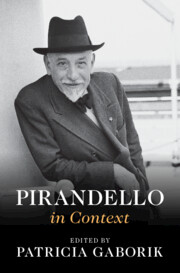Book contents
- Pirandello in Context
- Pirandello in Context
- Copyright page
- Dedication
- Contents
- Figures
- Contributors
- Preface
- Acknowledgments
- Chronology
- List of Cited Titles in Translation and the Original Italian
- Part I Places
- Part II Institutions
- Part III Interlocutors
- Part IV Traditions and Trends, Techniques and Forms
- Part V Culture and Society
- Chapter 25 History
- Chapter 26 Celebrity
- Chapter 27 Cinema
- Chapter 28 Modernity
- Chapter 29 Fascism
- Chapter 30 Women
- Chapter 31 Religion
- Chapter 32 Madness
- Chapter 33 Suicide
- Part VI Reception and Legacy
- Further Reading
- Index
Chapter 27 - Cinema
from Part V - Culture and Society
Published online by Cambridge University Press: 14 March 2024
- Pirandello in Context
- Pirandello in Context
- Copyright page
- Dedication
- Contents
- Figures
- Contributors
- Preface
- Acknowledgments
- Chronology
- List of Cited Titles in Translation and the Original Italian
- Part I Places
- Part II Institutions
- Part III Interlocutors
- Part IV Traditions and Trends, Techniques and Forms
- Part V Culture and Society
- Chapter 25 History
- Chapter 26 Celebrity
- Chapter 27 Cinema
- Chapter 28 Modernity
- Chapter 29 Fascism
- Chapter 30 Women
- Chapter 31 Religion
- Chapter 32 Madness
- Chapter 33 Suicide
- Part VI Reception and Legacy
- Further Reading
- Index
Summary
Introduced in the 1890s, cinema became a vital part of the culture to which Pirandello devoted his career. While he engaged to some extent with cinematic practice in promoting his works for adaptation or writing a screenplay from his Six Characters in Search of an Author, his relation to the medium lies predominantly in the conceptual affinities between cinema as a unique and pervasive means of expression and his philosophical outlook as theorized in the essay On Humor, the blueprint of his poetics. Describing an author’s disposition and its ensuing literary technique, “humor” is a conceptual model according to which the reliance on reason in attaining truth leads to an interpretation of experience in multiple, coexisting, and conflicting illusory constructs. This chapter examines Pirandello’s response to cinema’s aesthetic possibilities, which is evident in some of the short stories he recommended for adaptation and in the novel Shoot! and his screenplay from Six Characters, a metafictional inquiry into artistic creation whose protagonist and actor in that role would have been Pirandello himself.
- Type
- Chapter
- Information
- Pirandello in Context , pp. 219 - 226Publisher: Cambridge University PressPrint publication year: 2024

